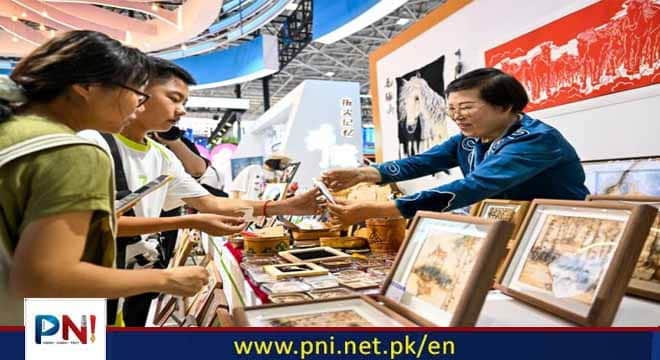HOHHOT, July 25 : Located on the main street of China’s only Russian ethnic township, Enhe, Inner Mongolia Autonomous Region, Wang Xiufen’s cafe exudes a warm, woody aroma. The scent of freshly brewed coffee mingles with the earthy smell of wood, drifting from a weathered log cabin — a traditional Russian-style house.
Step inside, and the eye is drawn to vibrant textiles: handwoven tapestries, colorful crocheted wall hangings, and intricate woolen ornaments, all crafted by Wang herself. For Wang, an inheritor of Russian ethnic textile craftsmanship, this cafe is more than a business. It’s a window for showcasing her ethnic traditions.
“Weaving was once passed down through generations in my family, but young people weren’t interested,” Wang said. “Now, they come for coffee, snap photos of these decorations, which are perfect for sharing on social media, and suddenly, they want to know more and even learn.”
Across the diverse ethnic communities in Inner Mongolia, many traditional craft inheritors are wrapping their cherished culture in new contexts to make heritage feel not like a relic, but a living, breathing part of the present.
A short walk away in Enhe, another custodian of tradition is reimagining her craft. Fu Yanmei has spent over 20 years making lieba, a Chinese transliteration of the Russian word for bread, and her bakery, once a quiet local staple, now buzzes with activity. Years ago, she launched a DIY lieba program, inviting visitors to shape the dough themselves.
But Fu doesn’t just let them bake — she tells them about lieba’s history and how it’s made with natural sourdough, no additives. Young tourists, she noted, make up most of the participants. “Tasting their own baked lieba is a joy they remember.”
Further east, in Oroqen Autonomous Banner near the Greater Khingan Mountains, the Oroqen people, one of China’s smallest ethnic groups, are also breathing new life into their heritage.
In the old days, they crafted canoes, cradles, baskets, and other tools and vessels from birch bark, prized for its waterproof and durable qualities. Today, at the Oroqen intangible cultural heritage museum, Meng Shuling, a master of birch bark craftsmanship, showcases these traditional items and her modern reinventions.
Her workshop showcases delicate birch bark earrings, glossy fridge magnets, and tiny cradle-shaped pendants, all pieces that marry the material’s natural texture with contemporary tastes.
“The old ways can’t stay locked in the past,” Meng said, running a finger over a birch bark jewelry box.
Beyond these grassroots efforts, institutional support is also fueling the revival of traditional crafts. Since 2023, Inner Mongolia’s institute of culture and tourism development, in collaboration with several universities, has launched a program to revitalize intangible cultural heritage by harnessing the creativity of the younger generation.
This initiative encourages students to draw inspiration from intangible heritage elements to create digital illustrations, IP characters, and fashion designs. To date, it has yielded more than 300 pieces of intangible heritage-themed cultural and creative design drafts and handicrafts.
“Young people want things they can wear, display and cherish daily. That’s how we keep the skill alive,” Meng said.
Follow the PNI Facebook page for the latest news and updates.








